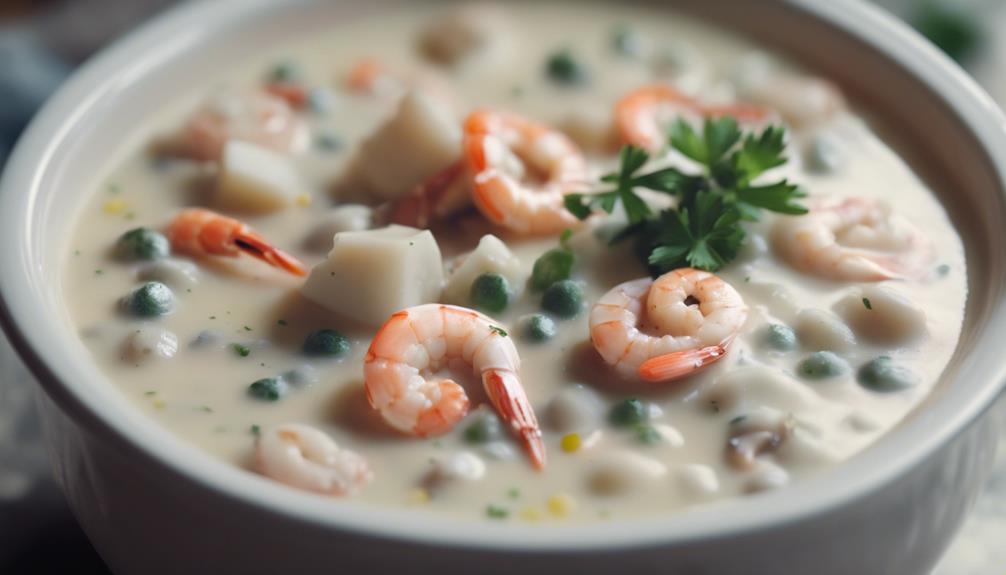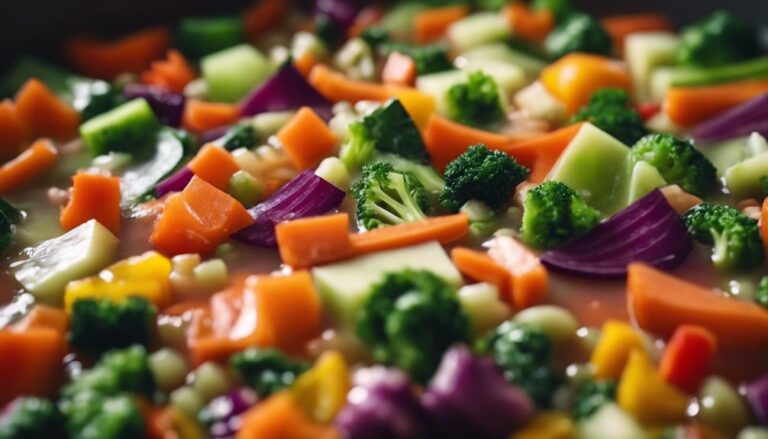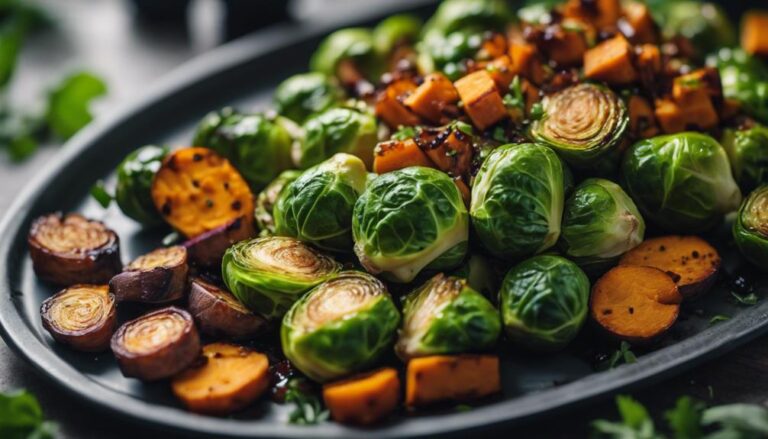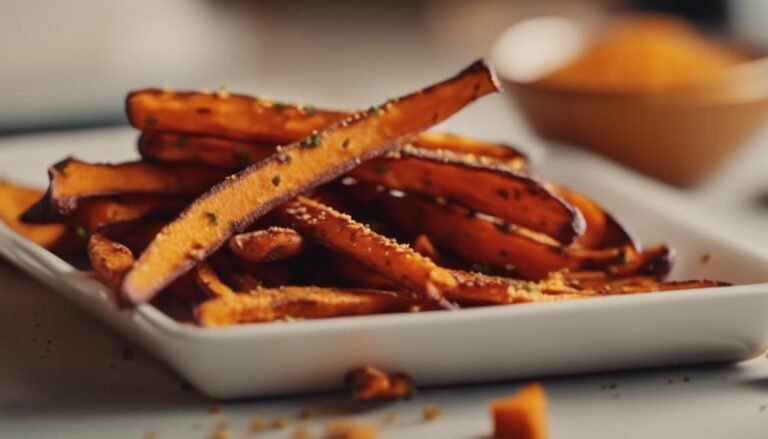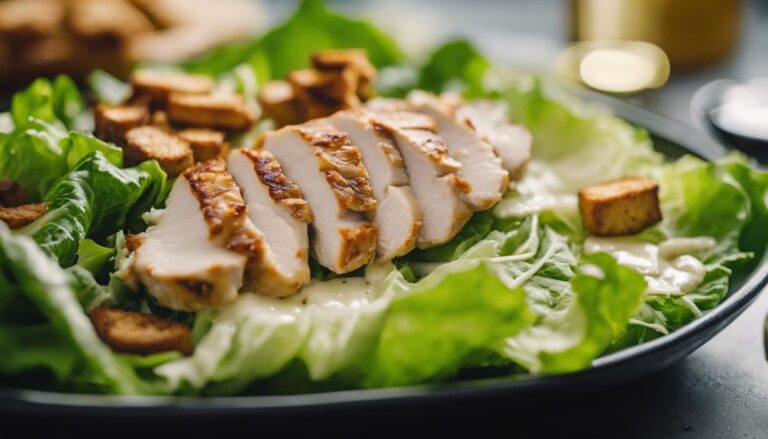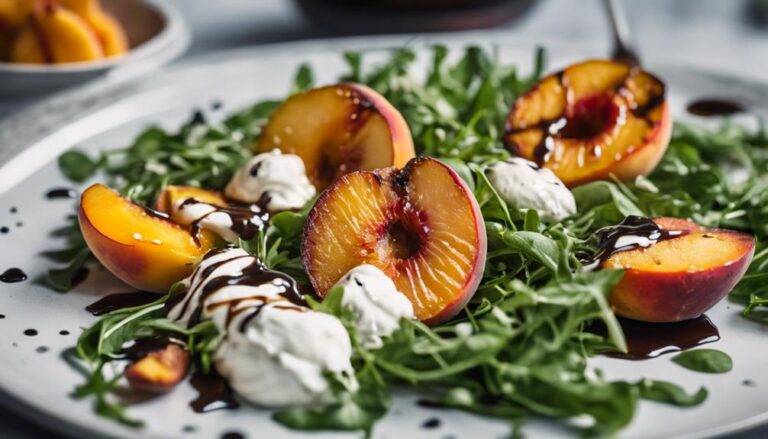Sous Vide Seafood Chowder With Coconut Cream
Explore a luxuriously creamy seafood chowder prepared using sous vide. Elevate the flavors with the velvety touch of coconut cream. Immerse yourself in a sumptuous seafood experience that promises to tantalize your taste buds. Reveal the secrets to creating a dish that merges the rich flavors of the sea with the tropical essence of coconut. Discover how this innovative method enhances the texture and taste of your chowder to perfection. Discover a world of culinary delight waiting for you to uncover its wonders.
What You Will Learn Here
- Infuse sous vide seafood with coconut cream for rich, creamy chowder.
- Experiment with herbs and spices for enhanced flavor profiles.
- Opt for sustainable seafood sourcing for eco-friendly choices.
- Consider lactose-free options with coconut cream for dietary needs.
- Ensure precise water bath control for consistent and velvety textures.
Chowder's Evolution Over Time
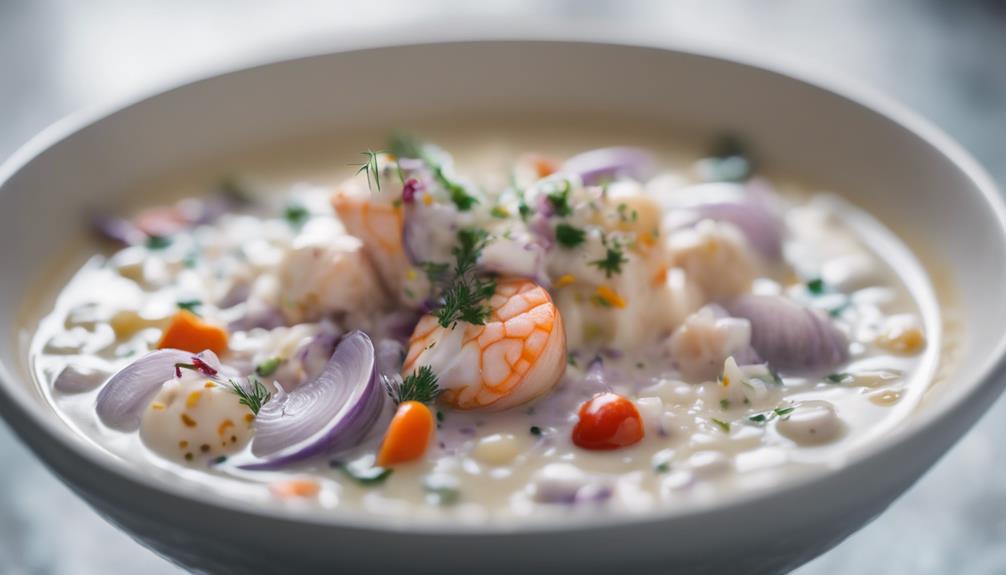
Chowder's evolution over time showcases a fascinating culinary journey, from its humble beginnings as a simple fish stew to the modern-day variations featuring diverse ingredients like potatoes, onions, and coconut cream.
Regional adaptations like New England clam chowder and Manhattan clam chowder have contributed to the rich tapestry of chowder flavors. The innovative incorporation of new elements reflects the dynamic nature of chowder, making it a versatile dish that continues to adapt to changing tastes and dietary preferences.
Historical Chowder Origins
Emerging from humble origins in the fishing villages of France and England during the 16th century, chowder evolved from a simple fish stew to a hearty soup incorporating seafood, vegetables, and cream.
The term 'chowder' originates from the French 'chaudiere,' denoting the large cooking pot used by fishermen at sea.
As chowder made its way to North America, it gained popularity, especially in regions like New England where clam chowder became renowned. Over time, recipes diversified to include various seafood, vegetables, and seasonings like fresh thyme and black pepper, enhancing flavors.
The evolution of chowder reflects regional tastes and ingredient availability, showcasing a rich culinary history.
When preparing chowder, remember to lower the heat after adding the cream to avoid curdling and maintain a velvety texture.
Modern Flavor Variations
As chowder expanded from its humble beginnings in fishing villages to a modern culinary landscape, innovative adaptations like incorporating coconut cream have redefined traditional flavors.
The substitution of coconut cream and milk in seafood chowder caters to dietary preferences, providing a lactose-free option without compromising on the creamy texture.
Modern chowder recipes adjust traditional ingredients, like cream and bacon, to accommodate special dietary considerations, such as lactose intolerance or vegetarianism.
Using coconut cream in seafood chowder adds a unique and tropical twist to the classic dish, appealing to those seeking innovative flavors.
Experimenting with different ingredients showcases the versatility of chowder and how it can adapt to contemporary culinary preferences.
Thank you so much for exploring these modern flavor variations; we're ready to serve you with delicious and creative chowder options.
Cultural Chowder Adaptations
Culinary evolution has seen seafood chowder transform through cultural adaptations, showcasing a rich tapestry of flavors and ingredients. Fusion cuisine has played an essential role in shaping chowder recipes, incorporating cultural influences like the innovative use of coconut cream.
Ingredient experimentation has led to the development of unique flavor profiles, expanding the traditional boundaries of this beloved dish. Dietary adaptations, such as catering to lactose intolerant individuals and vegetarians by introducing coconut cream, highlight the culinary creativity involved in chowder evolution.
Chowder's Key Seasoning Ingredients
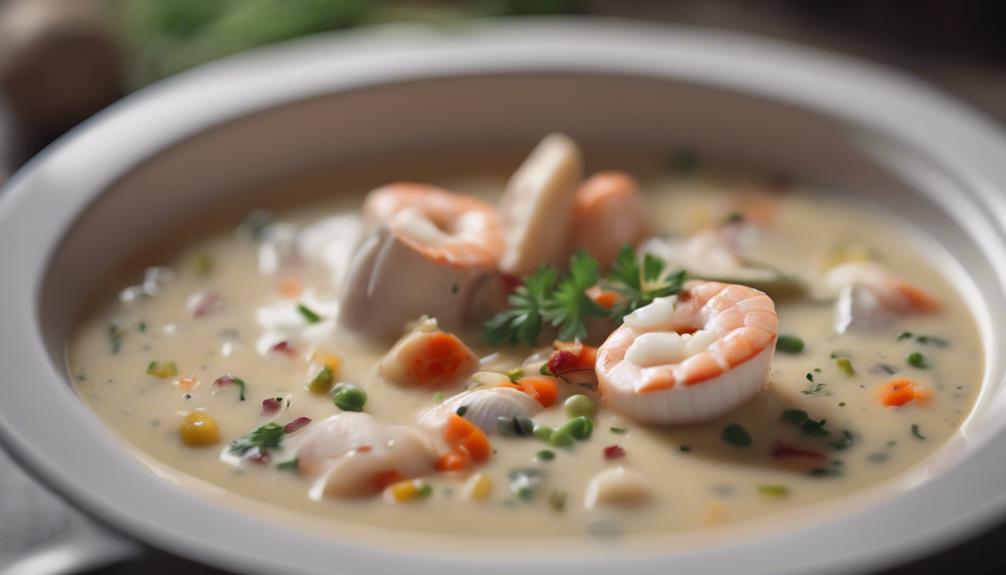
To enhance the flavor profile of your Sous Vide Seafood Chowder, the key seasoning ingredients of garlic, thyme, and black or white pepper play an essential role.
- Garlic: Known for its aromatic and pungent flavor, garlic adds depth and complexity to the chowder, enhancing the overall taste experience.
- Thyme: This herb contributes earthy and slightly floral notes, complementing the seafood flavors while providing a subtle herbaceous undertone.
- Black or White Pepper: The choice between black or white pepper allows for customization based on your preference for spiciness, with black pepper offering a more robust kick and white pepper providing a milder heat.
- Adjusting Pepper to Taste: Seasoning with pepper to taste allows for a personalized touch, catering to individual preferences for a more tailored dining experience.
Sous Vide Chowder Variations
Explore a world of delectable chowder variations with recipes like Sous Vide Lobster Chowder, Creamy Crab Chowder, and Smoked Salmon Chowder.
These unique twists on the classic dish offer a range of flavors and textures to suit your preferences.
Elevate your culinary experience by experimenting with different seafood options, herbs, and spices to create a personalized chowder masterpiece.
Sous Vide Lobster Chowder Recipe
For a decadent twist on classic seafood chowder, infuse your culinary repertoire with the velvety richness of sous vide lobster in a coconut cream base.
When considering sustainability, opt for lobster sourced from well-managed fisheries or certified sustainable options.
If dealing with coconut allergies, substitute coconut cream with a non-dairy alternative like almond or cashew cream.
Enhance the flavors of the chowder by pairing the sous vide lobster with complementary ingredients such as aromatic herbs like thyme or tarragon, a hint of citrus from lemon zest, or a dash of heat from a pinch of cayenne pepper.
This recipe promises a creamy and flavorful seafood dish that showcases the tender perfection achieved through sous vide cooking.
Creamy Crab Chowder Recipe
Incorporate the delicate flavors of sous vide-cooked crab into a velvety chowder base enriched with coconut cream for a luxurious twist on a classic seafood dish.
When preparing this creamy crab chowder, consider the following:
- Seafood Pairing: Combine the sous vide crab with fresh clams to elevate the seafood essence of the chowder.
- Cooking Techniques: Utilize sous vide methods for precise and consistent results when infusing the crab flavors into the dish.
- Ingredient Substitutions: Opt for coconut cream as a creamy, lactose-free alternative to traditional dairy cream.
- Flavor Enhancements: Enhance the overall taste profile by incorporating veal strips or bacon into the chowder for added depth and richness.
Smoked Salmon Chowder Recipe
To continue your culinary exploration, consider infusing the rich flavors of smoked salmon into a luxurious chowder base using the precision of sous vide cooking.
Key Points:
- Smoked salmon: Enhances the traditional seafood chowder with its unique and intense flavor profile.
- Coconut cream: Adds a creamy and dairy-free element, catering to various dietary preferences.
- Seafood innovation: Sous vide cooking method maintains the delicate texture and flavors of the smoked salmon, resulting in a tender and flavorful chowder.
- Delicious Variation: This innovative chowder offers a comforting dish perfect for seafood enthusiasts seeking a new culinary experience.
Sous Vide Timing Tips
When considering sous vide timing for seafood chowder, remember precision in timing is key. Keep a close eye on the water bath temperature to guarantee accuracy throughout the cooking process.
Adjust the cooking time accordingly based on the specific seafood being used for best results.
Precision in Timing
For precise results in your sous vide seafood chowder, mastering the timing is essential to achieve the perfect texture and doneness of the seafood.
Temperature precision is key to ensuring that the seafood is cooked evenly and retains its natural flavors.
Texture consistency and achieving the desired doneness levels depend on accurate timing in the sous vide process.
Timing accuracy is vital not only for flavor development but also for nutrient retention in the seafood chowder.
By following recommended sous vide timing guidelines, you can consistently create a delicious seafood chowder every time, with the added benefit of freeing up time for other meal preparations.
Your attention to timing detail will elevate your seafood chowder to a new level of culinary excellence.
Water Bath Control
Maintaining precise water bath control is fundamental in sous vide cooking for achieving consistent and ideal results, especially when preparing a seafood chowder with coconut cream.
Water bath maintenance is essential to guarantee temperature consistency, which directly impacts the cooking results of the seafood. By regulating the water temperature accurately with a reliable sous vide machine, you can elevate the flavors and textures of the chowder to perfection.
Precision timing plays a significant role in sous vide success, as it determines the doneness and overall quality of the dish. Monitoring the cooking times diligently will lead to a velvety and flavorful seafood chowder that will delight those you serve.
Temperature Accuracy
To guarantee excellent outcomes in your sous vide seafood chowder with coconut cream, precise temperature accuracy is vital for achieving the ideal texture and flavor profile.
Sous vide cooking allows for cooking precision and ingredient pairing, ensuring your seafood is perfectly cooked without losing its natural flavors. By maintaining temperature consistency throughout the cooking process, you can achieve a harmonious flavor balance in your chowder.
The sous vide benefits include texture control, where the seafood retains its tenderness and juiciness. Using a reliable sous vide machine with accurate temperature readings is essential for achieving consistent results.
Following recommended sous vide cooking times and temperatures for seafood will help you master the art of creating a delectable seafood chowder that will delight your guests.
Final Thoughts
In your culinary journey with sous vide seafood chowder enriched with coconut cream, consider the harmonious blend of flavors and dietary accommodations this dish provides. The customization options available, such as adjusting the pepper levels to suit individual tastes, guarantee a personalized dining experience. This chowder caters to a wide range of dietary requirements, making it a versatile and inclusive choice for gatherings and events. The flavor profiles of the seafood and coconut cream complement each other perfectly, creating a rich and satisfying dish that's sure to impress your guests.
When serving this delightful chowder, consider garnishing it with a sprinkle of black or white pepper to enhance the visual appeal and add a touch of sophistication. Remember to conduct the spoon test to check the readiness and consistency of the chowder before serving it hot to your excited diners. By taking these final thoughts into consideration, you'll elevate your dining experience with a dish that isn't only delicious but also thoughtfully crafted to accommodate various preferences and dietary needs.
Frequently Asked Questions
What Is a Thickening Agent for Seafood Chowder?
For seafood chowder, consider using cornstarch as a flour substitute for thickening. Arrowroot powder or xanthan gum are also effective options. Gelatin powder can provide a unique texture, while tapioca starch offers a gluten-free alternative.
What Is a Good Thickener for Clam Chowder?
For clam chowder, a good thickener could be cornstarch or arrowroot for gluten-free options, flour or roux for traditional creaminess, potato starch for a hearty touch, or gelatin for a unique twist. Each provides a distinct texture.
Why Is My Chowder Not Thickening?
If your chowder isn't thickening, it could be due to cornstarch troubles or using flour alternatives. Gelatin solutions might help too. Adjusting these elements and simmering adequately can help achieve that desired consistency.
What Was Added to the Chowder to Thicken It?
To thicken the chowder, you incorporated a flour roux. This blend of flour and fat was mixed with sauteed ingredients. The roux binds everything together, creating a creamy, thick consistency that enhances the overall texture of the dish.
Conclusion
Indulge in the rich and velvety sous vide seafood chowder with coconut cream, a modern twist on a classic favorite.
By harnessing the precise cooking method of sous vide, every ingredient is perfectly infused with flavor, resulting in a decadent and unforgettable culinary experience.
Elevate your chowder game with this luxurious dish that will leave your taste buds craving more.
Bon appétit!
